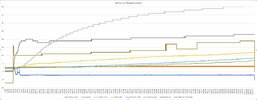I didnt care to look at the video. Did they let the car stand outside to let the battery cool down ?
27-22F is below freezing ( 0C) so if the car had been cooled down there had been a need for battery heating as Tesla do not allow charging below 0C. Lithium batteries doesnt like to be charged at or below freezing. Batteriy below 1C would need heating.
For me charging with a 1phase 230V (3kW) the car every now and then needs to heat the battery even if I start the charging when arriving with rest heat in the battery. Parked after a long drive around time 20:00 (8pm) with battery temp 16.75C. Connected the car asap to get the benifit from the battery temp from the drive. After about 6hrs the battery was down to 7.5C and that did trigger the battery heating. The heater in on at about 7.5 to 8.25C and push the temp up. Outside temp was -9.5C to -6C ( 15 to 6F)
At 1C, the max BMS charge limit enters 0kW as can be seen at the note in this picture.
The car was charged 03:30 to 06:20 and the cell temp did rise from 4C to 19.25C without any battery heating at all.
If the car has been outside, and the battery has cooled down to low temperature the battery heating will go on and depending on how much charging power that is used, the efficiency will go down and the time to charge will go up.
This is teslafi numbers, and the efficiency often is 85-95% on UMC signle phase 3kW charging at my mother in laws place.
This charge was timed to not have to cool battery. Efficiency 62%.
The worst charges did end up at about 35-37% efficiency, if the battery already did cool down, and then comnected to that single phase 3kW charges. Then it forst would not charge until the battery was a few degrees C. Before this only battery heating and during the charging battery heating would be needed to keep the temp up.



